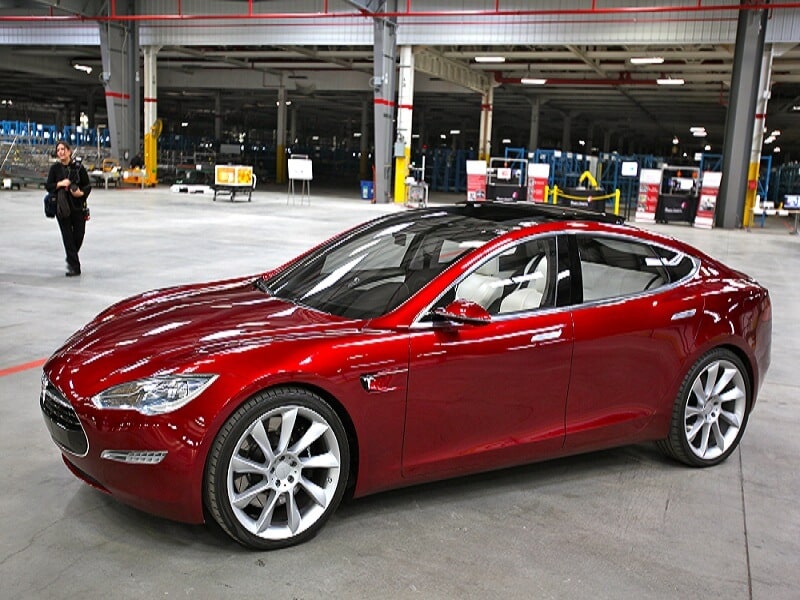Tesla Motors Inc (NASDAQ:TSLA) Chief Technical Officer, JB Straubel, has revealed more details about the company’s fully-electrical vision. Information about the long-awaited, entry-level Model 3 remains speculative, but we now know that it will be offered in both Sedan and Crossover versions.
So far, Tesla’s models have been offered with a single body style with various performance packages, and premium price tags. This high-end, high-ticket approach has sold a modest 60,000 units as of 2014. With a release set for 2017, Elon Musk fully expects the Model 3 to sell 10 times as many units by 2020.
According to Elon Musk, the vehicle will have a range of at least 200 miles, similar to previous models. But with its so-called “third-generation” lithium-ion battery array, it will debut with an estimated MSRP of $35,000—half that of Tesla’s second and only current production vehicle, the Model S. By featuring model variation, the automaker may be trying to dominate the electric car market in the same way that the Ford F-Series has lead the truck market for decades. And without 100-years of gasoline polluting its waters, Tesla has been able to drive public attention to its small pond.
Founded in 2003, Tesla reached initial profitability by the end of 2009. It’s flashy ($109,000) 288 hp Roadster Sport won many early awards although only 2,450 units were delivered when the first-generation vehicle was halted in 2012. The Tesla Model S sedan was introduced in 2012 and the 4WD Crossover Model X is set to hit the roads later this year.
Straubel has credited the company’s continued development of smaller, lighter lithium-ion batteries with multiple firms including Samsung SDI and Panasonic Corp. But as Chevrolet, Nissan, and others race to release their own fully-electric vehicles, will Tesla’s investments be enough to establish a 21st automobile mark, or will it, like its namesake, give its contributions for an inevitable technology?
Trusted & Regulated Stock & CFD Brokers
What we like
- 0% Fees on Stocks
- 5000+ Stocks, ETFs and other Markets
- Accepts Paypal Deposits
Min Deposit
$200
Charge per Trade
Zero Commission on real stocks
64 traders signed up today
Visit Now67% of retail investor accounts lose money when trading CFDs with this provider. You should consider whether you can afford to take the high risk of losing your money.
Available Assets
- Total Number of Stocks & Shares5000+
- US Stocks
- German Stocks
- UK Stocks
- European
- ETF Stocks
- IPO
- Funds
- Bonds
- Options
- Futures
- CFDs
- Crypto
Charge per Trade
- FTSE 100 Zero Commission
- NASDAQ Zero Commission
- DAX Zero Commission
- Facebook Zero Commission
- Alphabet Zero Commission
- Tesla Zero Commission
- Apple Zero Commission
- Microsoft Zero Commission
Deposit Method
- Wire Transfer
- Credit Cards
- Bank Account
- Paypall
- Skrill
- Neteller
What we like
- Sign up today and get $5 free
- Fractals Available
- Paypal Available
Min Deposit
$0
Charge per Trade
$1 to $9 PCM
Visit Now
Investing in financial markets carries risk, you have the potential to lose your total investment.
Available Assets
- Total Number of Shares999
- US Stocks
- German Stocks
- UK Stocks
- European Stocks
- EFTs
- IPOs
- Funds
- Bonds
- Options
- Futures
- CFDs
- Crypto
Charge per Trade
- FTSE 100 $1 - $9 per month
- NASDAQ $1 - $9 per month
- DAX $1 - $9 per month
- Facebook $1 - $9 per month
- Alphabet $1 - $9 per month
- Telsa $1 - $9 per month
- Apple $1 - $9 per month
- Microsoft $1 - $9 per month
Deposit Method
- Wire Transfer
- Credit Cards
- Bank Account



